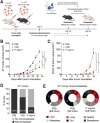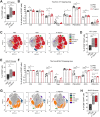Piper nigrum extract suppresses tumor growth and enhances the antitumor immune response in murine models of breast cancer and melanoma
- PMID: 37464192
- PMCID: PMC10491708
- DOI: 10.1007/s00262-023-03487-3
Piper nigrum extract suppresses tumor growth and enhances the antitumor immune response in murine models of breast cancer and melanoma
Abstract
Although the antitumor effect of P. nigrum has been widely studied, research related to its possible immunomodulatory effects is relatively scarce. Here, the antitumor and immunomodulatory activity of an ethanolic extract of P. nigrum were evaluated in the murine models of 4T1 breast cancer and B16-F10 melanoma. In vitro evaluations showed that the P. nigrum extract has cytotoxic activity, induces apoptotic cell death, and has a pro-oxidant effect in both cell lines, but it regulates glucose uptake differently in both lines, decreasing it in 4T1 but not in B16-F10. P. nigrum extract significantly reduced tumor size in both models and decreased the occurrence of macrometastases in 4T1 model. Evaluation of immune subpopulations by flow cytometry revealed that the P. nigrum extract significantly increases the frequency of dendritic cells and activated CD8+ T cells and decreases the frequency of myeloid-derived suppressor like cells and Tregs in the tumor microenvironment of both models but with different dynamics. Our findings strongly suggest that the P. nigrum extract exerts immunomodulatory functions, slightly related to the modulation of cellular energy metabolism, which could ultimately contribute to the promising antitumor effect of P. nigrum.
Keywords: Antitumor; Breast cancer; Immunomodulation; Melanoma; Piper nigrum; Plant extracts.
© 2023. The Author(s).
Conflict of interest statement
S.F. and C.U. are inventors of a granted patent related to P2Et. SF and CU are partners of the DreemBio company who was a licensee of related patents. The rest of the authors declare no competing interests.
Figures







Similar articles
-
Tillandsia usneoides Extract Decreases the Primary Tumor in a Murine Breast Cancer Model but Not in Melanoma.Cancers (Basel). 2022 Nov 1;14(21):5383. doi: 10.3390/cancers14215383. Cancers (Basel). 2022. PMID: 36358804 Free PMC article.
-
Piper nigrum ethanolic extract rich in piperamides causes ROS overproduction, oxidative damage in DNA leading to cell cycle arrest and apoptosis in cancer cells.J Ethnopharmacol. 2016 Aug 2;189:139-47. doi: 10.1016/j.jep.2016.05.020. Epub 2016 May 10. J Ethnopharmacol. 2016. PMID: 27178634
-
An Immunomodulatory Gallotanin-Rich Fraction From Caesalpinia spinosa Enhances the Therapeutic Effect of Anti-PD-L1 in Melanoma.Front Immunol. 2020 Nov 18;11:584959. doi: 10.3389/fimmu.2020.584959. eCollection 2020. Front Immunol. 2020. PMID: 33312174 Free PMC article.
-
A systematic review on black pepper (Piper nigrum L.): from folk uses to pharmacological applications.Crit Rev Food Sci Nutr. 2019;59(sup1):S210-S243. doi: 10.1080/10408398.2019.1565489. Epub 2019 Feb 11. Crit Rev Food Sci Nutr. 2019. PMID: 30740986
-
Overview of the Anticancer Potential of the "King of Spices" Piper nigrum and Its Main Constituent Piperine.Toxins (Basel). 2020 Nov 26;12(12):747. doi: 10.3390/toxins12120747. Toxins (Basel). 2020. PMID: 33256185 Free PMC article. Review.
Cited by
-
An Overview of the Spices Used for the Prevention and Potential Treatment of Gastric Cancer.Cancers (Basel). 2024 Apr 22;16(8):1611. doi: 10.3390/cancers16081611. Cancers (Basel). 2024. PMID: 38672692 Free PMC article. Review.
-
Triple negative breast cancer migration is modified by mitochondrial metabolism alteration induced by natural extracts of C. spinosa and P. alliacea.Sci Rep. 2024 Aug 31;14(1):20253. doi: 10.1038/s41598-024-70550-z. Sci Rep. 2024. PMID: 39215068 Free PMC article.
-
Harnessing the anticancer potential of Piper nigrum: a synergistic approach to chemotherapy enhancement and reduced side effects.Discov Oncol. 2025 Jan 6;16(1):10. doi: 10.1007/s12672-024-01716-4. Discov Oncol. 2025. PMID: 39760812 Free PMC article. Review.
-
Spices and culinary herbs for the prevention and treatment of breast cancer: A comprehensive review with mechanistic insights.Cancer Pathog Ther. 2024 Jul 6;3(3):197-214. doi: 10.1016/j.cpt.2024.07.003. eCollection 2025 May. Cancer Pathog Ther. 2024. PMID: 40458304 Free PMC article. Review.
-
Phytochemical analysis of leaf extract of Piper nigrum and investigation of its biological activities.Inflammopharmacology. 2025 Jun;33(6):3255-3277. doi: 10.1007/s10787-025-01701-5. Epub 2025 Apr 18. Inflammopharmacology. 2025. PMID: 40251438
References
-
- Asprey G, Thornton P. Medical plants of Jamaica. The West Indian Med J. 1954;3:17–41. - PubMed
-
- Kirtikar K, Basu B (1935) Indian medicinal plants. Indian Medicinal Plants
-
- Ahmad N, Fazal H, Abbasi BH, Farooq S, Ali M, Khan MA. Biological role of Piper nigrum L. (Black pepper): a review. Asian Pac J Trop Biomed. 2012;2:S1945–S1953. doi: 10.1016/S2221-1691(12)60524-3. - DOI
MeSH terms
Substances
LinkOut - more resources
Full Text Sources
Medical
Research Materials
Miscellaneous

